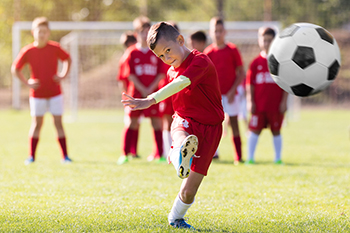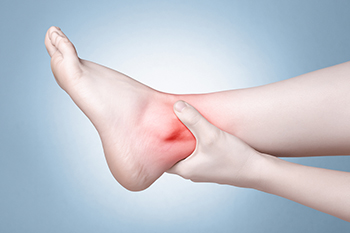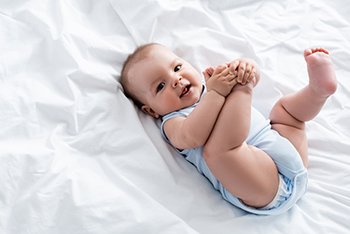Connect With Us
Blog
Items filtered by date: October 2025
Gout Pain Can Be Managed
Linking Heel Pain and Youth Soccer

Heel pain is one of the most frequent complaints in young soccer players, often linked to the growth plate in the heel bone. This area, called the calcaneal apophysis, is soft and more vulnerable to stress during growth. When leg bones lengthen faster than the heel bone, extra tension develops, sometimes leading to inflammation known as calcaneal apophysitis, or Sever’s disease. Symptoms usually include throbbing or aching pain at the back of the heel, which may worsen with running, jumping, or wearing certain cleated shoes. Turf cleats generally provide better cushioning and reduce strain compared to grass cleats, which can put extra stress on the heel. A podiatrist can evaluate the cause of heel pain, recommend proper footwear, and provide treatment options that allow young athletes to remain active safely. If your child exhibits signs of heel pain after sports activities, it is suggested that you schedule an appointment with a podiatrist for an exam and appropriate treatment.
Sever's disease often occurs in children and teens. If your child is experiencing foot or ankle pain, see one of our podiatrists from Kokomo Foot & Ankle Center. Our doctors can treat your child’s foot and ankle needs.
Sever’s Disease
Sever’s disease is also known as calcaneal apophysitis, which is a medical condition that causes heel pain I none or both feet. The disease is known to affect children between the ages of 8 and 14.
Sever’s disease occurs when part of the child’s heel known as the growth plate (calcaneal epiphysis) is attached to the Achilles tendon. This area can suffer injury when the muscles and tendons of the growing foot do not keep pace with bone growth. Therefore, the constant pain which one experiences at the back of the heel will make the child unable to put any weight on the heel. The child is then forced to walk on their toes.
Symptoms
Acute pain – Pain associated with Sever’s disease is usually felt in the heel when the child engages in physical activity such as walking, jumping and or running.
Highly active – Children who are very active are among the most susceptible in experiencing Sever’s disease, because of the stress and tension placed on their feet.
If you have any questions, please feel free to contact our office located in Contact Us . We offer the newest diagnostic and treatment technologies for all your foot care needs.
Understanding Ankle Pain When Walking

Ankle pain while walking can be caused by several conditions, including gout, osteoarthritis, and peripheral neuropathy. Gout is a form of inflammatory arthritis caused by a buildup of uric acid crystals in the joint, leading to sudden, intense pain, swelling, and redness. Osteoarthritis results from the gradual wear and tear of cartilage, causing stiffness, aching, and decreased mobility in the ankle joint. Peripheral neuropathy involves nerve damage, often due to diabetes or other medical conditions, and can cause burning, tingling, or numbness in the ankle and foot. The pain may feel sharp, throbbing, or burning and can worsen with activity. A podiatrist can provide an accurate diagnosis through a physical examination, medical history review, and imaging or nerve studies. Treatment options may include medication, lifestyle modifications, orthotics, o,r in some cases, surgery. To address ankle pain effectively and improve mobility, it is suggested that you schedule an appointment with a podiatrist.
Ankle pain can be caused by a number of problems and may be potentially serious. If you have ankle pain, consult with one of our podiatrists from Kokomo Foot & Ankle Center. Our doctors will assess your condition and provide you with quality foot and ankle treatment.
Ankle pain is any condition that causes pain in the ankle. Due to the fact that the ankle consists of tendons, muscles, bones, and ligaments, ankle pain can come from a number of different conditions.
Causes
The most common causes of ankle pain include:
- Types of arthritis (rheumatoid, osteoarthritis, and gout)
- Ankle sprains
- Broken ankles
- Achilles tendonitis
- Achilles tendon rupture
- Stress fractures
- Bursitis
- Tarsal tunnel syndrome
- Plantar fasciitis
Symptoms
Symptoms of ankle injury vary based upon the condition. Pain may include general pain and discomfort, swelling, aching, redness, bruising, burning or stabbing sensations, and/or loss of sensation.
Diagnosis
Due to the wide variety of potential causes of ankle pain, podiatrists will utilize a number of different methods to properly diagnose ankle pain. This can include asking for personal and family medical histories and of any recent injuries. Further diagnosis may include sensation tests, a physical examination, and potentially x-rays or other imaging tests.
Treatment
Just as the range of causes varies widely, so do treatments. Some more common treatments are rest, ice packs, keeping pressure off the foot, orthotics and braces, medication for inflammation and pain, and surgery.
If you have any questions please feel free to contact our office located in Contact Us . We offer the newest diagnostic tools and technology to treat your foot and ankle needs.
When Babies Need Shoes and How to Choose the Right Pair

Babies do not need shoes until they begin walking outside, as barefoot play helps strengthen muscles and improve balance. When it is time for their first pair, choose shoes with a wide toe box to allow natural movement, a flexible sole with grip for stability, and adjustability to encourage independence. A semi flexible heel cup provides gentle support, while a slight toe raise helps with forward motion. A podiatrist can guide parents in selecting the best shoes for healthy foot development and check for any early concerns. If your baby is ready for their first shoes, it is suggested that you schedule a visit with a podiatrist to ensure comfort, protection, and healthy growth for tiny feet.
The health of a child’s feet is vital to their overall well-being. If you have any questions regarding foot health, contact one of our podiatrists of Kokomo Foot & Ankle Center. Our doctors can provide the care you need to keep you pain-free and on your feet.
Tips for Keeping Children's Feet Healthy
- Make sure their shoes fit properly
- Look for any signs of in-toeing or out-toeing
- Check to see if they have Clubfoot (condition that affects your child’s foot and ankle, twisting the heel and toes inward) which is one of the most common nonmajor birth defects.
- Lightly cover your baby’s feet (Tight covers may keep your baby from moving their feet freely, and could prevent normal development)
- Allow your toddler to go shoeless (Shoes can be restricting for a young child’s foot)
- Cut toenails straight across to avoid ingrown toenails
- Keep your child’s foot clean and dry
- Cover cuts and scrapes. Wash any scratches with soap and water and cover them with a bandage until they’ve healed.
If you have any questions, please feel free to contact our office located in Contact Us . We offer the newest diagnostic and treatment technologies for all your foot care needs.
Types of Webbed Toes in Newborns

Webbed toes, also called syndactyly, occur when two or more toes are joined together at birth. This condition develops during fetal growth when the tissue between toes does not fully separate. Webbed toes may appear alone or as part of a genetic condition, and the type depends on how much tissue is involved. In simple syndactyly, only skin and soft tissue connect the toes. Complex syndactyly involves bones, with some or all toes fused together. Complicated syndactyly goes further, where abnormal bone or tendon formation creates additional changes in the foot. The most common form affects the second and third toes, but fusion can also occur between the fourth and fifth toes. A podiatrist can evaluate the extent of fusion, discuss whether surgery is needed to improve function or appearance, and guide the recovery process. If you have a child born with webbed toes, it is suggested that you schedule an appointment with a podiatrist for an exam, diagnosis, and treatment.
Congenital foot problems require immediate attention to avoid future complications. If you have any concerns, contact one of our podiatrists of Kokomo Foot & Ankle Center. Our doctors can provide the care you need to keep you pain-free and on your feet.
Congenital foot problems are deformities affecting the feet, toes, and/or ankles that children are born with. Some of these conditions have a genetic cause while others just happen. Some specific foot ailments that children may be born with include clubfeet, polydactyly/macrodactyly, and cleft foot. There are several other foot anomalies that can occur congenitally. What all of these conditions have in common is that a child may experience difficulty walking or performing everyday activities, as well as trouble finding footwear that fits their foot deformity. Some of these conditions are more serious than others. Consulting with a podiatrist as early as possible will help in properly diagnosing a child’s foot condition while getting the necessary treatment underway.
What are Causes of Congenital Foot Problem?
A congenital foot problem is one that happens to a child at birth. These conditions can be caused by a genetic predisposition, developmental or positional abnormalities during gestation, or with no known cause.
What are Symptoms of Congenital Foot Problems?
Symptoms vary by the congenital condition. Symptoms may consist of the following:
- Clubfoot, where tendons are shortened, bones are shaped differently, and the Achilles tendon is tight, causing the foot to point in and down. It is also possible for the soles of the feet to face each other.
- Polydactyly, which usually consists of a nubbin or small lump of tissue without a bone, a toe that is partially formed but has no joints, or an extra toe.
- Vertical talus, where the talus bone forms in the wrong position causing other bones in the foot to line up improperly, the front of the foot to point up, and the bottom of the foot to stiffen, with no arch, and to curve out.
- Tarsal coalition, when there is an abnormal connection of two or more bones in the foot leading to severe, rigid flatfoot.
- Cleft foot, where there are missing toes, a V-shaped cleft, and other anatomical differences.
- Macrodactyly, when the toes are abnormally large due to overgrowth of the underlying bone or soft tissue.
Treatment and Prevention
While there is nothing one can do to prevent congenital foot problems, raising awareness and receiving neonatal screenings are important. Early detection by taking your child to a podiatrist leads to the best outcome possible.
If you have any questions, please feel free to contact our office located in Contact Us . We offer the newest diagnostic and treatment technologies for all your foot care needs.

